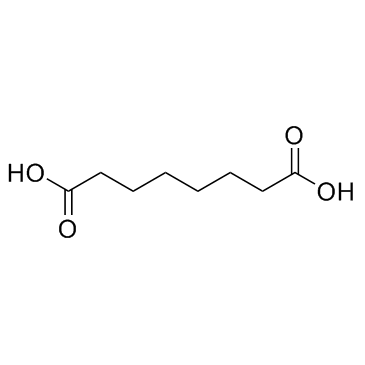Octanedioic acid

Octanedioic acid structure
|
Common Name | Octanedioic acid | ||
|---|---|---|---|---|
| CAS Number | 505-48-6 | Molecular Weight | 174.194 | |
| Density | 1.2±0.1 g/cm3 | Boiling Point | 361.2±25.0 °C at 760 mmHg | |
| Molecular Formula | C8H14O4 | Melting Point | 140-144 °C(lit.) | |
| MSDS | Chinese USA | Flash Point | 186.5±19.7 °C | |
| Symbol |

GHS07 |
Signal Word | Warning | |
|
Physiology and pathophysiology of organic acids in cerebrospinal fluid.
J. Inherit. Metab. Dis. 16(4) , 648-69, (1993) Concentrations of organic acids in cerebrospinal fluid (CSF) appear to be directly dependent upon their rate of production in the brain. There is evidence that the net release of short-chain monocarboxylic acids from the brain is a major route for removing th... |
|
|
Age-related reference values for urinary organic acids in a healthy Turkish pediatric population.
Clin. Chem. 40(6) , 862-6, (1994) Organic acid concentrations were quantified by gas chromatography and the individual acids identified by mass spectrometry in urine specimens from a healthy Turkish pediatric population of ages 2 days to 16 years, subdivided into five age groups. We quantifie... |
|
|
Metabolomic profiles delineate potential role for sarcosine in prostate cancer progression.
Nature 457(7231) , 910-4, (2009) Multiple, complex molecular events characterize cancer development and progression. Deciphering the molecular networks that distinguish organ-confined disease from metastatic disease may lead to the identification of critical biomarkers for cancer invasion an... |
|
|
Automated screening of urine samples for carbohydrates, organic and amino acids after treatment with urease.
J. Chromatogr. A. 562(1-2) , 125-38, (1991) Eighty-five clinical urine samples and nineteen urine samples previously found by other laboratories to suggest genetic metabolic defects were prepared for trimethylsilylation by treatment with urease, followed by azeotropic dehydration. The "Target Analyte S... |
|
|
Quantitative analysis for organic acids in biological samples: batch isolation followed by gas chromatographic-mass spectrometric analysis.
Clin. Chem. 35(4) , 587-95, (1989) This new method for qualitative and quantitative determination of organic acids, aldehydes, and ketones in biological samples is effective for use with urine, plasma, and amniotic fluid, and it requires no deproteinization. Isolation by batch-wise liquid part... |
|
|
Abnormal urinary excretion of unsaturated dicarboxylic acids in patients with medium-chain acyl-CoA dehydrogenase deficiency.
J. Lipid Res. 31(5) , 763-71, (1990) Medium-chain acyl-CoA dehydrogenase (MCAD) deficiency is the most frequently described metabolic disorder of fatty acid oxidation in humans. Acute episodes are usually characterized biochemically by the appearance of nonketotic dicarboxylic aciduria. In addit... |
|
|
Urinary and plasma organic acids and amino acids in chronic fatigue syndrome.
Clin. Chim. Acta 361(1-2) , 150-8, (2005) Previous work by others have suggested the occurrence of one or more chemical or metabolic 'markers' for ME/CFS including specific amino acids and organic acids and a number of unidentified compounds (CFSUM1, CFSUM2). We have shown elsewhere that CFSUM1 is pa... |
|
|
Structural variation governs substrate specificity for organic anion transporter (OAT) homologs. Potential remote sensing by OAT family members.
J. Biol. Chem. 282 , 23841-53, (2007) Organic anion transporters (OATs, SLC22) interact with a remarkably diverse array of endogenous and exogenous organic anions. However, little is known about the structural features that determine their substrate selectivity. We examined the substrate binding ... |
|
|
Detection of autosomal dominant polycystic kidney disease by NMR spectroscopic fingerprinting of urine.
Kidney Int. 79(11) , 1244-53, (2011) Autosomal dominant polycystic kidney disease (ADPKD) is a frequent cause of kidney failure; however, urinary biomarkers for the disease are lacking. In a step towards identifying such markers, we used multidimensional-multinuclear nuclear magnetic resonance (... |
|
|
Broad spectrum analysis of polar and apolar organic compounds in submicron atmospheric particles.
J. Chromatogr. A. 1404 , 28-38, (2015) A method for the quantitative analysis of organic compounds on submicron particulate matter (PM1) collected on quartz filters was developed. The compounds analyzed encompassed C22-C35 alkanes, polycyclic aromatic hydrocarbons (PAHs), quinones, levoglucosan, c... |